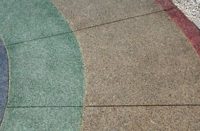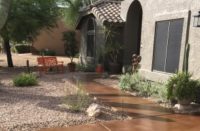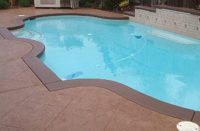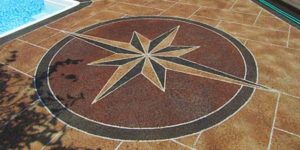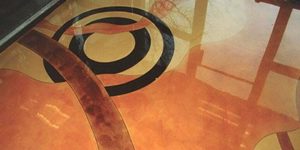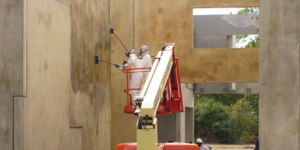Over the last couple of years, I’ve written articles on how I use math to break down design layout and my views of color theory. This time, I’m going to share one of the little details that help my projects look amazing — how to properly use a brush. More specifically, hand brush details on concrete borders.
I’ve talked with many of you over the years. You spend hours taping and masking your borders’ minutest details so you can spray and be done in minutes. Most of you think using a brush would take longer. I beg to disagree … once you’ve acquired the knack. Just like most other tools you use, it takes practice. You won’t master proper brushing techniques overnight.
A brush in the hand
Brushes are the most underutilized tool in any concrete contractor’s arsenal. They don’t cost a lot and most times are disposable after each use. They allow me not to spend a fortune on plastic and waste time masking off everything. Instead, I get down on my hands and knees and brush every detail.
The first thing you need to know is how to hold a brush. Even though the handle is larger, hold it the same way you would hold a pen or pencil. The grip shouldn’t feel awkward. Don’t hold it like a knife as if you were about to smear peanut butter on your border. You have limited control holding it like that.
From acid stains and water-based stains to dyes and sealers, I have different techniques when applying. For this article, we’ll just focus on how to brush acid stain.
Going for a dip
After you get used to properly holding the brush, you need to understand how to dip it. Never, I repeat never, dip your brush so far into your acid stain that it touches the metal frame. You’ll get too much stain up into the brush and it will drip everywhere. The most important guideline to brushing is not to drip.
There is a simple way to ensure no drip. Dip your brush into the stain so that only the bottom half to one inch, at the most, is wet. Then lift your brush out of the stain and forcefully lift and lower the brush a short distance twice to get rid of excess stain while it’s still over the cup. Don’t move so forcefully that you splatter the stain.
 Make sure you don’t fill the cup too much so there’s room for this step. If you quickly do this twice, you should have no dripping whatsoever. I can travel three to four feet away from my cup with no drips.
Make sure you don’t fill the cup too much so there’s room for this step. If you quickly do this twice, you should have no dripping whatsoever. I can travel three to four feet away from my cup with no drips.
You must be diligent and consistent with this technique. If you’re not careful, you can drip a color in the wrong area. It only takes one mistake to tarnish the borders’ overall look. It’s important to repeat the same steps every single time you dip your brush.
Getting up to speed
Before we get into when the brush touches the surface, I’d like to point out one more thing. Once you start brushing, don’t just use your wrist to move the brush. Use your entire arm. Think of the brush as an extension of your arm. Move your arm from the shoulder all the way to the brush at one time. This will help you control splatter, edges and all movements you need to ensure consistent application.
 Now let’s get into the actual application. Brushing acid stain is different for all concrete surfaces. It’s easier to hand brush a smooth hard-troweled floor than it is to brush a heavily broomed floor. Be aware and prepared for this ahead of time. It’s also easier to see brush marks on smooth surfaces than it is to see them on rougher textures.
Now let’s get into the actual application. Brushing acid stain is different for all concrete surfaces. It’s easier to hand brush a smooth hard-troweled floor than it is to brush a heavily broomed floor. Be aware and prepared for this ahead of time. It’s also easier to see brush marks on smooth surfaces than it is to see them on rougher textures.
Regardless of which texture, the technique is similar. You must pay attention to how much surface each dip will cover. Don’t brush too far on one side or the other of your border. Move at an even pace around the perimeter, especially with acid stain. I usually plan to dip and brush about 5 inches at a time. This depends on the border’s width but it’s a good average to plan for. As you apply the stain, swirl the brush in a consistent and slow motion.
 Start in the middle of the space you plan to brush and work your way to the edges. Once you reach the edges, you can brush in a straight line. Make sure you stain the entire edge because if you don’t, you’ll see spots with color and no color the next day. They will stand out.
Start in the middle of the space you plan to brush and work your way to the edges. Once you reach the edges, you can brush in a straight line. Make sure you stain the entire edge because if you don’t, you’ll see spots with color and no color the next day. They will stand out.
Once you get the edges done, lightly go back to swirling them into the middle. This will get rid of the straight brush marks you made down the edges.
In the photo here, you can see a job I was called to where the installer brushed the edges first and then went back and stained the center. Notice how the edges stand out from staining at different times. This is why you must stain the entire border all at once.
 The goal to hand brushing is to brush at a speed where you can keep a wet edge. You don’t want to go too slow or push the material so far that you start brushing it to the point of it getting dry.
The goal to hand brushing is to brush at a speed where you can keep a wet edge. You don’t want to go too slow or push the material so far that you start brushing it to the point of it getting dry.
By keeping a slight puddle as you brush, you’ll allow the stain to react instead of showing every single mark you make. It only takes a couple of projects where you use this technique and you’ll master a brush. Stop wasting all that plastic and start practicing with a brush.
Video Tutorial
